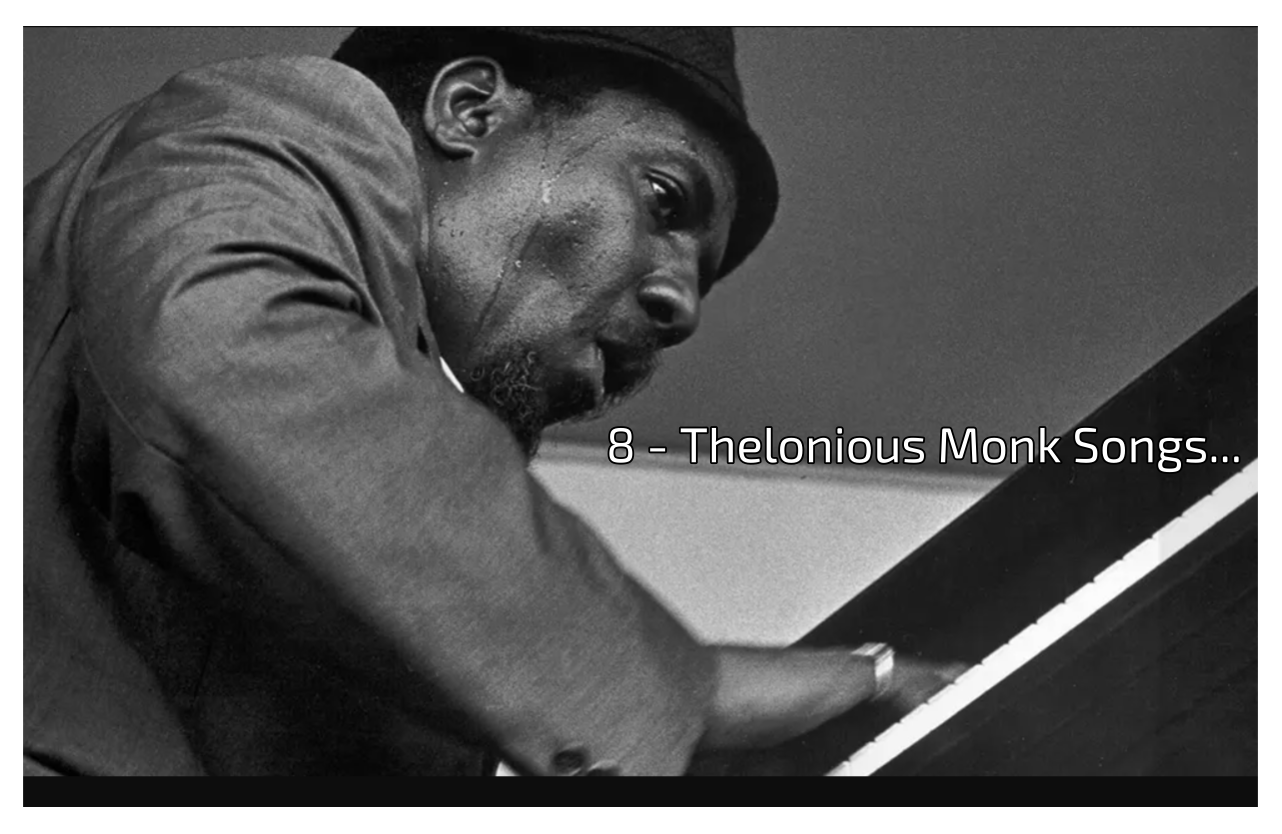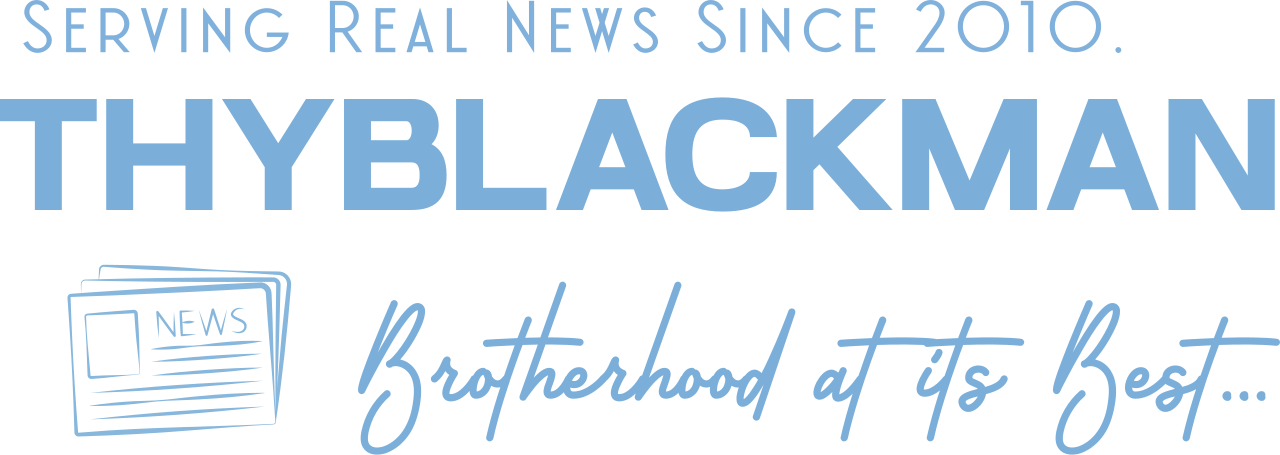(ThyBlackMan.com) There’s something about Thelonious Monk that grabs you—not with force, but with curiosity. You lean in when he plays, like someone telling a story just low enough to make you listen close. He doesn’t dazzle with flash or run wild with speed. Monk invites you into a world where wrong notes are right, silence swings as hard as sound, and the piano doesn’t just speak—it grins, stumbles, sighs, and testifies.
For me, discovering Monk was like finding a hidden jazz club that only appears when the night is quiet enough. His music is strange, yes, but only because it’s honest. Every tune is a fingerprint, and once you’ve heard him, you can’t mistake him for anyone else. Some call him quirky. I say he was free—free to make beauty out of what others might call broken.
These eight songs aren’t just “classics” to study—they’re moments to live inside. They carry emotion, intellect, and a touch of mystery. Whether you’re a lifelong Monk devotee or just stepping into his world, these tunes are a perfect way to get lost—and maybe find something you didn’t know you needed.

1. ‘Round Midnight
Perhaps Monk’s most famous composition, “‘Round Midnight” is not just a jazz standard—it’s a nocturnal hymn, a meditation in musical form. Written in the early 1940s and first recorded in 1944, the piece stands as an emotional centerpiece of Monk’s repertoire and a milestone in jazz history. It has the moody, brooding quality of a torch song but filtered through Monk’s unique harmonic lens. With its haunting minor key theme and deliberate pacing, it feels like a walk through a deserted city street long after the last train has left.
Monk plays with time itself in this piece, stretching phrases and leaning on dissonance not as a gimmick but as an expressive device. The melody soars, dips, and breathes—it’s not constrained by the bar lines. And in his solo renditions, Monk’s use of space is remarkable. He lets the silences linger just long enough to make you hold your breath. He creates a sonic chiaroscuro—bright flares of harmony flickering against deep shadows of silence.
Over the decades, “‘Round Midnight” has become a rite of passage for jazz musicians. Miles Davis added orchestral textures to it. Carmen McRae sang it with quiet devastation. Yet Monk’s own interpretations—especially the 1957 Thelonious Himself version—still carry unmatched emotional gravity. They cut deeper, lingering longer in the listener’s soul. There’s a complexity underneath the mournful tone that feels personal, almost autobiographical.
In 2025, the track continues to speak across generations. It appeals to fans of lo-fi beats, ambient music, and modern composition as much as it does to traditional jazz listeners. It’s the perfect blend of intellect and emotion. Put on a pair of headphones, dim the lights, and let Monk lead you into that sacred after-midnight space where reflection becomes inevitable. This isn’t just a jazz song—it’s a feeling you return to when the world is too loud.
2. Blue Monk
If you want to understand how Thelonious Monk could both honor and reinvent the blues, “Blue Monk” is the clearest example. Structured around a classic 12-bar blues form, the piece unfolds with an elegance that’s almost deceptive. There’s no flashiness in the melody—just a sly, syncopated swing that invites you in like an old friend. But dig deeper, and you’ll hear the brilliant subversions Monk places underneath that traditional frame.
It’s in the phrasing: Monk’s melodies don’t quite land where you expect them to. His timing is slightly behind the beat, or abruptly ahead of it, creating a push-pull dynamic that’s unmistakably his. His left-hand basslines are chunky and grounded, but his right hand—ah, that’s where the magic happens. Those angular fills, those odd note choices—they make you tilt your head and smile. It’s a form of musical mischief.
Despite being frequently taught in music schools and jam sessions, “Blue Monk” never feels academic. It’s deeply human. There’s grit in the grooves, vulnerability in the pauses, and humor in the phrasing. Monk turns the piano into a voice box for pure emotion—never overwrought, but always soulful. The spaces between the notes allow listeners to step in and feel their own version of the blues.
Today, “Blue Monk” remains fresh and relevant. You could easily imagine it sampled in a hip-hop track, reimagined as a neo-soul ballad, or looped into a lo-fi beat. The tune is grounded in tradition, but its elasticity makes it a living, breathing piece of music. It’s a reminder that the blues aren’t just about sorrow—they’re about survival, wit, and style.
3. Straight, No Chaser
“Straight, No Chaser” is a walking contradiction—in the best possible way. On the surface, it’s a traditional B-flat blues. But in Monk’s hands, it becomes a funky labyrinth. It struts more than it swings, and yet it never loses its place. The melody is bare-bones: just a few notes tossed out like dice on a bar table. But Monk’s phrasing adds so much weight that it feels almost architectural in its design.
This is Monk’s blues, not the Delta variety. It’s urban, cerebral, and proudly eccentric. The beauty of this piece lies in its rough edges—the clashing harmonies, the unexpected hesitations, the rhythmic displacement. Monk doesn’t play around the beat; he plays with it, reshaping time to suit his vision. His solos are filled with snags and turns, but each decision feels purposeful, as if he’s letting us hear the inner monologue of genius in real-time.
The title itself suggests something about Monk’s philosophy: unfiltered, unsweetened, and unapologetically honest. He wasn’t interested in virtuosity for its own sake. Instead, he chased character, sound, and truth. “Straight, No Chaser” is his musical autobiography. Every bar is stamped with his signature. Even in group performances, you feel his imprint in the pauses, the tension, the swing that always limps just a little.
In today’s musical landscape, this piece is more than just a jazz tune—it’s a masterclass in groove, abstraction, and innovation. Whether interpreted by Wynton Marsalis, Robert Glasper, or left alone in Monk’s original form, it remains potent. It reminds us that beauty can be jagged and rhythm can be personal. Monk didn’t follow the path—he carved one.
4. Epistrophy
“Epistrophy” might be the most misunderstood jewel in Monk’s crown. Co-written with drummer Kenny Clarke in 1941, it was ahead of its time then—and still challenges listeners today. Structurally, it defies easy categorization. The melody is abrasive and angular, the chord changes are dense, and the rhythm feels like it’s tripping over itself—on purpose. It’s Monk the iconoclast, inviting us into his most abstract world.
The name itself—”Epistrophy”—is a linguistic nod to rhetorical repetition, but it also implies circularity. And that’s exactly what the song does. It loops back on itself, each pass adding new contours, slight detours, or sly surprises. Listening to “Epistrophy” is like watching an Escher staircase—it feels endless and multi-dimensional. You’re never quite sure which way is up, but it’s thrilling nonetheless.
Musically, it’s an incredible conversation between Monk and Clarke. The drum patterns mirror Monk’s phrasing, creating a polyrhythmic texture that still sounds revolutionary. You can hear this influence echoed decades later in the free jazz movement and even in genres like experimental hip-hop and electronic music. This is Monk in his most punk form—breaking rules not for shock, but to reveal deeper truths.
In 2025, “Epistrophy” feels like a call to artistic courage. It asks you not to relax into beauty but to chase it through chaos. For musicians, it’s a gauntlet. For listeners, it’s an invitation to challenge your ears and assumptions. And for Monk, it was a statement: complexity can be soulful, and discord can be divine.
5. Ruby, My Dear
“Ruby, My Dear” showcases a rarely discussed facet of Thelonious Monk’s genius—his capacity for romantic tenderness. Composed in the early 1940s and named after Ruby Richardson, a woman he had once loved in high school, the tune is as poignant as anything in the jazz ballad repertoire. While Monk is often celebrated for his angular, dissonant phrasing and rhythmic daring, this piece proves he could also compose music of heartbreaking vulnerability.
The melody flows with a mournful grace, each note thoughtfully placed like a line in a love letter. Yet true to Monk’s sensibilities, even his romanticism isn’t conventional. The harmonies are thick with tension—not to create discomfort, but to suggest the complex emotions that often accompany love. There’s beauty here, but it’s a beauty tinged with melancholy, longing, and a touch of regret. It’s a slow dance between resolution and unresolved feeling.
The 1957 version featuring John Coltrane stands as one of the greatest ballad performances in jazz history. Coltrane’s rich, yearning tenor tone floats over Monk’s delicate comping like a conversation between two hearts unsure whether to hold on or let go. There is no rush, no urgency—just the measured patience of two masters listening to one another deeply. The space between notes is where the emotion truly lives.
Even in today’s high-speed, instant-gratification world, “Ruby, My Dear” stops time. It invites introspection, encourages softness, and dares you to feel without pretense. It’s the jazz equivalent of a bittersweet memory—achingly specific and yet completely universal. In a catalog brimming with innovation, this ballad reminds us that Monk’s genius included emotional fluency as much as technical brilliance.
6. Well, You Needn’t
There’s a sly smile behind every note of “Well, You Needn’t.” The title itself—reportedly Monk’s retort to a friend’s advice about pursuing a woman—captures the tune’s witty and mischievous character. This is Monk the jester, toying with jazz form and function, making listeners lean in with raised eyebrows and a grin. The melody begins with a rising motif that seems almost self-important, only to tumble playfully down the scale and land in a tight groove.
This composition is one of Monk’s most recorded pieces, and for good reason—it’s a treasure trove of rhythmic and harmonic challenges. The tune is structured to encourage improvisation but also subtly demands that musicians engage with its stubborn personality. Pianists in particular have to navigate tricky hand coordination, unexpected chordal voicings, and Monk’s typical rhythmic traps. It’s a masterclass in tension and release, always walking the line between playful and profound.
Monk’s own recordings, especially those from the late 1950s, contain a sense of mischief that no cover quite captures. His phrasing is clipped and percussive, as if he’s tossing musical ideas across the room just to see who’ll catch them. The rhythm section stays light on its feet, following Monk’s unpredictable left turns without missing a beat. It’s jazz as high-wire act—controlled chaos with deep logic.
In our current age of music shaped by loops and formulas, “Well, You Needn’t” feels wonderfully alive. It reminds listeners that great music doesn’t have to be polished or predictable. In fact, it’s Monk’s embrace of oddity and imperfection that gives the piece its enduring charm. It swings hard, but it also smirks—jazz with a wink.
7. Evidence
“Evidence” is Monk at his most cerebral and sly. Originally called “Justice” and derived from the standard “Just You, Just Me,” this tune is a classic example of how Monk loved to deconstruct existing material and rebuild it with his own logic. The final title, “Evidence,” is a pun—a legal metaphor and a nod to its transformation from its source material. Leave it to Monk to turn a jazz tune into both a courtroom exhibit and a riddle.
Musically, “Evidence” is built on jarring, clipped melodic phrases and rhythmic asymmetry. The melody doesn’t “sing” in the traditional sense—it stutters, skips, and stops. The piano becomes a typewriter of percussive ideas, more statement than song. It can be bewildering at first, especially to ears tuned to smoother jazz styles. But dig beneath the surface, and you’ll find an exquisite form of minimalist poetry.
The piece thrives in the space between what’s said and what’s suggested. Monk’s use of silence and abrupt phrasing turns the composition into a kind of musical satire, poking at the conventions of swing and harmony. He wasn’t mocking the tradition—he was expanding it, asking us to look at jazz from a different angle. The tune swings, yes, but it’s a swing that’s been refracted through a cracked mirror, yielding fascinating results.
“Evidence” still resonates with modern listeners and musicians, particularly those drawn to experimental or abstract forms. Its starkness and sparseness anticipate developments in avant-garde jazz, hip-hop production, and even glitch music. It’s Monk daring you to think differently, to hear music not just as entertainment but as intellectual engagement. In 2025, when innovation often comes dressed in digital effects, this bare-bones brilliance still holds weight.
8. In Walked Bud
“In Walked Bud” is Monk’s musical love letter to his close friend and fellow bebop pioneer, Bud Powell. While Monk and Powell had stylistic differences, they shared a deep bond and mutual admiration, and this tune celebrates Powell’s brilliance with all the vibrancy and swagger Monk could muster. It’s a tribute wrapped in rhythm, harmony, and infectious swing.
The structure of the piece borrows from the standard “Blue Skies,” but Monk transforms it completely. The melody is angular, delivered with punchy precision, and brimming with bounce. Monk’s phrasing suggests a kind of internal dance—his fingers hopping across the keys like someone making their grand entrance into a crowded room. It’s easy to imagine Powell “walking in,” turning heads with his presence, and sitting down at the piano to blow everyone away.
One of the most engaging versions of the tune features lyrics by Jon Hendricks, turning the piece into a narrative of Powell’s legendary entrance at a gig. The vocal rendition adds storytelling charm to an already theatrical composition. But instrumental versions carry just as much energy. Monk’s solos are playful yet respectful, full of the quirky rhythmic twists that make his playing so instantly identifiable.
“In Walked Bud” endures because it captures more than just musical admiration—it embodies friendship, camaraderie, and creative legacy. It reminds us that jazz is not just a genre; it’s a community of artists pushing each other toward greatness. Even in today’s fragmented music scene, this song serves as a joyful reminder of what happens when genius is met with respect, humor, and a whole lot of swing.
Monk’s music doesn’t ask for your approval—it asks for your attention. It doesn’t explain itself. It just is. And that’s part of the magic. In every offbeat accent, in every note that seems to trip over itself before landing just right, he’s telling you something about life: it’s not always smooth, but it can still swing.
Even today, with our earbuds, our streaming playlists, and our fast-scrolling lives, Monk makes us slow down. He reminds us that there’s genius in taking your time, in coloring outside the lines, in letting the music breathe. These eight songs are proof that what was once seen as “odd” is now timeless.
So the next time the night feels still and you’ve got a moment to yourself, put on a Monk tune. Don’t worry about “getting it.” Just listen. Feel it. Let it surprise you. That’s the beauty of Monk—he always leaves room for you in the music.
Staff Writer; Jamar Jackson

















Leave a Reply